2007 CHEVROLET SUBURBAN cooling
[x] Cancel search: coolingPage 119 of 634

3. Slide the new battery into the transmitter with
the positive side of the battery facing down.
Use a type CR2032 battery, or equivalent type.
Make sure the cover is on tightly, so water will
not get in.
4. Snap the front and the back of the transmitter
together.
5. Test the operation of the transmitter with the
vehicle.
Remote Vehicle Start
Your vehicle may have a remote starting feature.
This feature allows you to start the engine from
outside of the vehicle. It may also start up the
vehicle’s heating or air conditioning systems and
rear window defogger. Normal operation of the
system will return after the key is turned to the RUN
position.
During a remote start, if your vehicle has an
automatic climate control system, the climate
control system will default to a heating mode during
colder outside temperatures and a cooling mode
during warmer outside temperatures. If your vehicle
does not have an automatic climate control system,
during remote start, the climate control system will
turn on at the setting the vehicle was set to when
the vehicle was last turned off.During a remote start, if your vehicle has an
automatic climate control system and heated
seats, the heated seats will turn on during colder
outside temperatures and will shut off when
the key is turned to RUN. If your vehicle does not
have an automatic climate control system,
during remote start, you will need to manually turn
the heated seats on and off. SeeHeated Seats
on page 12for additional information.
Laws in some communities may restrict the use of
remote starters. For example, some laws may
require a person using the remote start to have the
vehicle in view when doing so. Check local
regulations for any requirements on remote starting
of vehicles.
Do not use the remote start feature if your vehicle
is low on fuel. Your vehicle may run out of fuel.
The RKE transmitter with the remote start button,
provides an increased range of operation. However,
the range may be less while the vehicle is running.
As a result, you may need to be closer to your
vehicle to turn it off, than you were to turn it on.
There are other conditions which can affect the
performance of the transmitter, seeRemote
Keyless Entry (RKE) System on page 114for
additional information.
119
Page 125 of 634
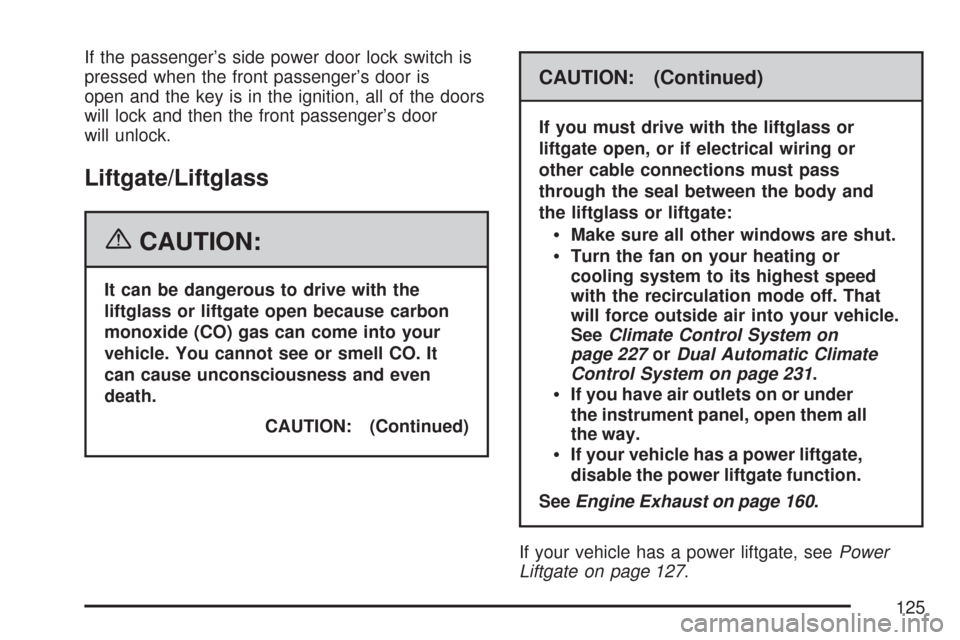
If the passenger’s side power door lock switch is
pressed when the front passenger’s door is
open and the key is in the ignition, all of the doors
will lock and then the front passenger’s door
will unlock.
Liftgate/Liftglass
{CAUTION:
It can be dangerous to drive with the
liftglass or liftgate open because carbon
monoxide (CO) gas can come into your
vehicle. You cannot see or smell CO. It
can cause unconsciousness and even
death.
CAUTION: (Continued)
CAUTION: (Continued)
If you must drive with the liftglass or
liftgate open, or if electrical wiring or
other cable connections must pass
through the seal between the body and
the liftglass or liftgate:
Make sure all other windows are shut.
Turn the fan on your heating or
cooling system to its highest speed
with the recirculation mode off. That
will force outside air into your vehicle.
SeeClimate Control System on
page 227orDual Automatic Climate
Control System on page 231.
If you have air outlets on or under
the instrument panel, open them all
the way.
If your vehicle has a power liftgate,
disable the power liftgate function.
SeeEngine Exhaust on page 160.
If your vehicle has a power liftgate, seePower
Liftgate on page 127.
125
Page 130 of 634

It is not recommended that you drive with the
liftgate open, however, if you must drive with the
liftgate open, the power liftgate should be switched
to manual liftgate operation — the overhead
console switch set to the “Disable” position.
Both the liftglass and liftgate have an electric latch.
If the battery is disconnected or has low voltage,
the liftglass and liftgate will not open. The
liftglass and liftgate will resume operation when
the battery is reconnected and charged.
If the battery is properly connected and has
adequate voltage, and the liftgate or liftglass still
will not function, your vehicle should be taken to a
dealership for service.
{CAUTION:
It can be dangerous to drive with the
liftglass or liftgate open because carbon
monoxide (CO) gas can come into your
vehicle. You cannot see or smell CO. It can
cause unconsciousness and even death.
CAUTION: (Continued)
CAUTION: (Continued)
If you must drive with the liftglass or
liftgate open, or if electrical wiring or
other cable connections must pass
through the seal between the body and
the liftglass or liftgate:
Make sure all other windows are shut.
Turn the fan on your heating or
cooling system to its highest speed
with the recirculation mode off. That
will force outside air into your vehicle.
SeeClimate Control System on
page 227orDual Automatic Climate
Control System on page 231.
If you have air outlets on or under
the instrument panel, open them all
the way.
If your vehicle has a power liftgate,
disable the power liftgate function.
SeeEngine Exhaust on page 160.
130
Page 221 of 634
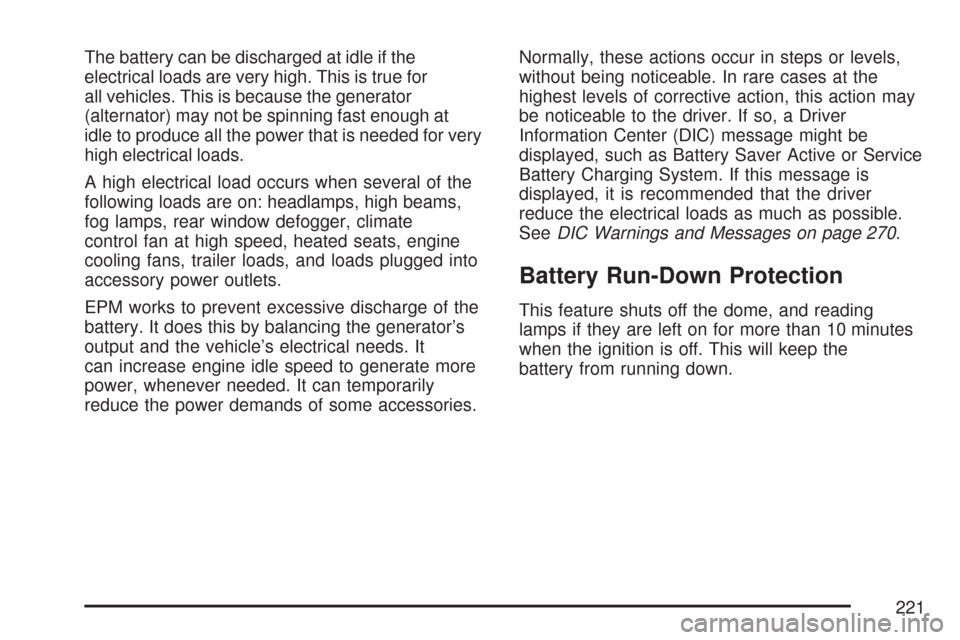
The battery can be discharged at idle if the
electrical loads are very high. This is true for
all vehicles. This is because the generator
(alternator) may not be spinning fast enough at
idle to produce all the power that is needed for very
high electrical loads.
A high electrical load occurs when several of the
following loads are on: headlamps, high beams,
fog lamps, rear window defogger, climate
control fan at high speed, heated seats, engine
cooling fans, trailer loads, and loads plugged into
accessory power outlets.
EPM works to prevent excessive discharge of the
battery. It does this by balancing the generator’s
output and the vehicle’s electrical needs. It
can increase engine idle speed to generate more
power, whenever needed. It can temporarily
reduce the power demands of some accessories.Normally, these actions occur in steps or levels,
without being noticeable. In rare cases at the
highest levels of corrective action, this action may
be noticeable to the driver. If so, a Driver
Information Center (DIC) message might be
displayed, such as Battery Saver Active or Service
Battery Charging System. If this message is
displayed, it is recommended that the driver
reduce the electrical loads as much as possible.
SeeDIC Warnings and Messages on page 270.
Battery Run-Down Protection
This feature shuts off the dome, and reading
lamps if they are left on for more than 10 minutes
when the ignition is off. This will keep the
battery from running down.
221
Page 227 of 634
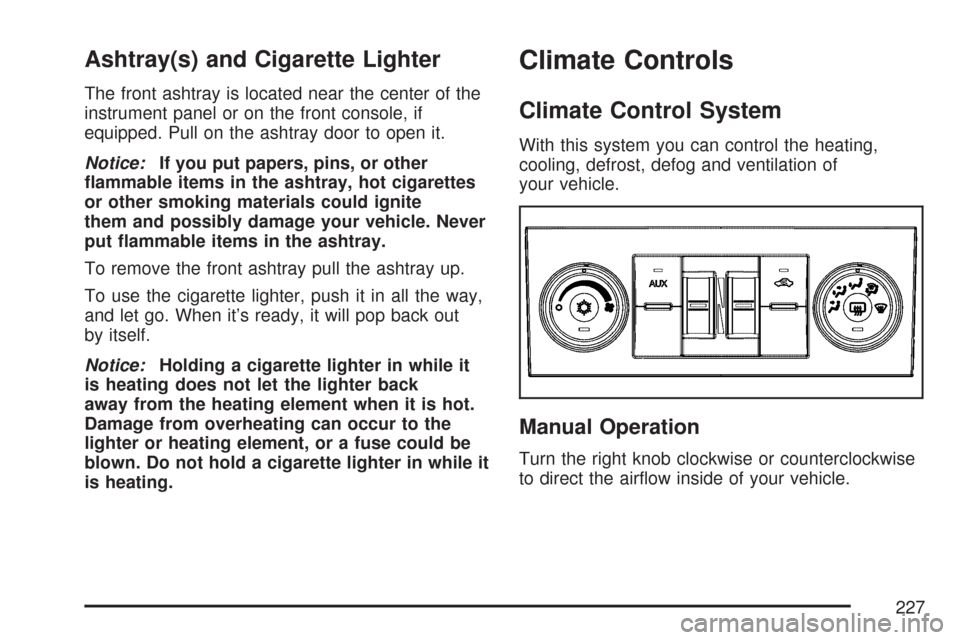
Ashtray(s) and Cigarette Lighter
The front ashtray is located near the center of the
instrument panel or on the front console, if
equipped. Pull on the ashtray door to open it.
Notice:If you put papers, pins, or other
�ammable items in the ashtray, hot cigarettes
or other smoking materials could ignite
them and possibly damage your vehicle. Never
put �ammable items in the ashtray.
To remove the front ashtray pull the ashtray up.
To use the cigarette lighter, push it in all the way,
and let go. When it’s ready, it will pop back out
by itself.
Notice:Holding a cigarette lighter in while it
is heating does not let the lighter back
away from the heating element when it is hot.
Damage from overheating can occur to the
lighter or heating element, or a fuse could be
blown. Do not hold a cigarette lighter in while it
is heating.
Climate Controls
Climate Control System
With this system you can control the heating,
cooling, defrost, defog and ventilation of
your vehicle.
Manual Operation
Turn the right knob clockwise or counterclockwise
to direct the air�ow inside of your vehicle.
227
Page 231 of 634
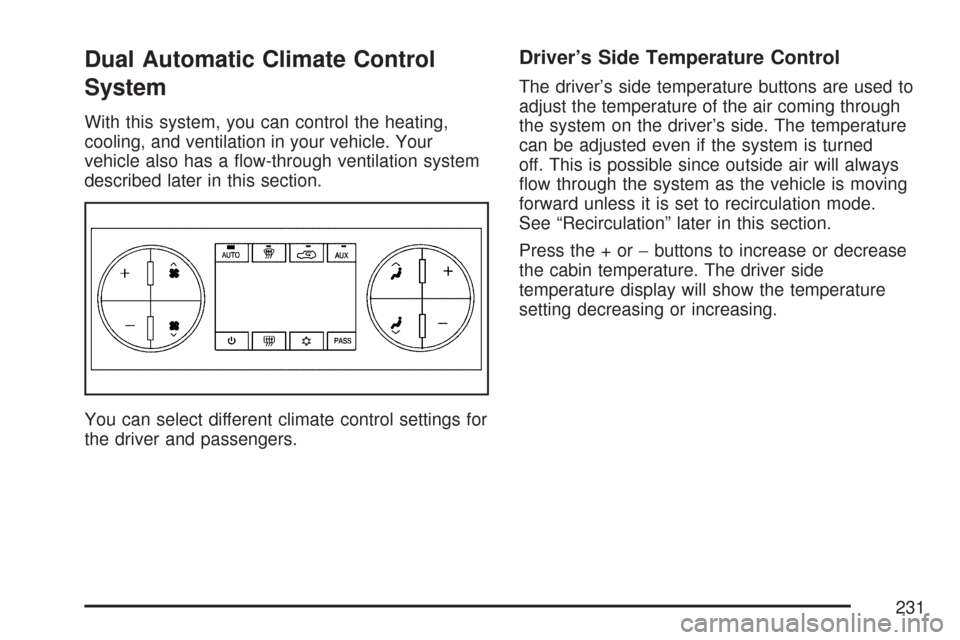
Dual Automatic Climate Control
System
With this system, you can control the heating,
cooling, and ventilation in your vehicle. Your
vehicle also has a �ow-through ventilation system
described later in this section.
You can select different climate control settings for
the driver and passengers.
Driver’s Side Temperature Control
The driver’s side temperature buttons are used to
adjust the temperature of the air coming through
the system on the driver’s side. The temperature
can be adjusted even if the system is turned
off. This is possible since outside air will always
�ow through the system as the vehicle is moving
forward unless it is set to recirculation mode.
See “Recirculation” later in this section.
Press the + or−buttons to increase or decrease
the cabin temperature. The driver side
temperature display will show the temperature
setting decreasing or increasing.
231
Page 233 of 634
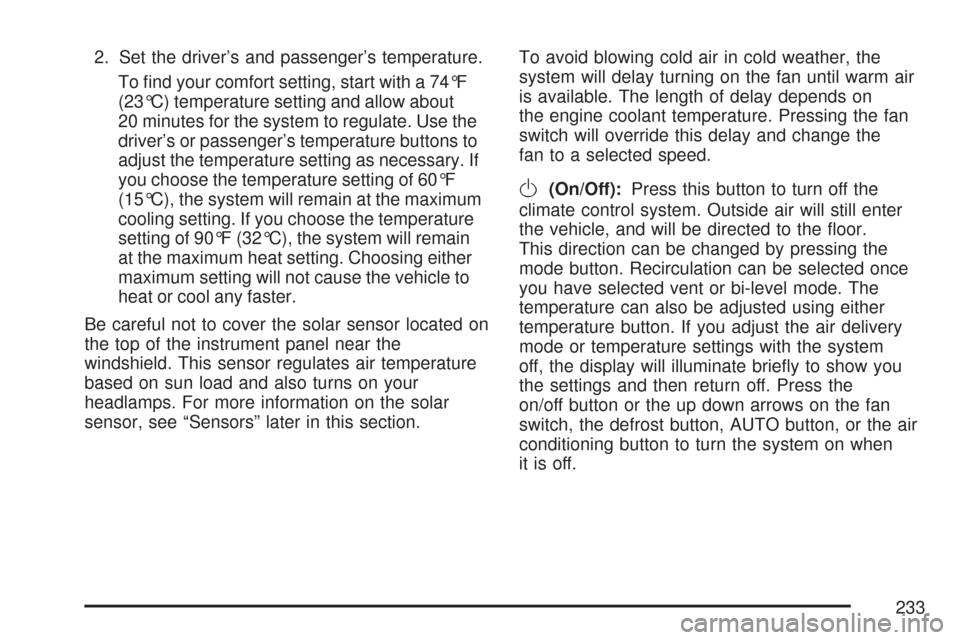
2. Set the driver’s and passenger’s temperature.
To �nd your comfort setting, start with a 74°F
(23°C) temperature setting and allow about
20 minutes for the system to regulate. Use the
driver’s or passenger’s temperature buttons to
adjust the temperature setting as necessary. If
you choose the temperature setting of 60°F
(15°C), the system will remain at the maximum
cooling setting. If you choose the temperature
setting of 90°F (32°C), the system will remain
at the maximum heat setting. Choosing either
maximum setting will not cause the vehicle to
heat or cool any faster.
Be careful not to cover the solar sensor located on
the top of the instrument panel near the
windshield. This sensor regulates air temperature
based on sun load and also turns on your
headlamps. For more information on the solar
sensor, see “Sensors” later in this section.To avoid blowing cold air in cold weather, the
system will delay turning on the fan until warm air
is available. The length of delay depends on
the engine coolant temperature. Pressing the fan
switch will override this delay and change the
fan to a selected speed.
O(On/Off):Press this button to turn off the
climate control system. Outside air will still enter
the vehicle, and will be directed to the �oor.
This direction can be changed by pressing the
mode button. Recirculation can be selected once
you have selected vent or bi-level mode. The
temperature can also be adjusted using either
temperature button. If you adjust the air delivery
mode or temperature settings with the system
off, the display will illuminate brie�y to show you
the settings and then return off. Press the
on/off button or the up down arrows on the fan
switch, the defrost button, AUTO button, or the air
conditioning button to turn the system on when
it is off.
233
Page 252 of 634
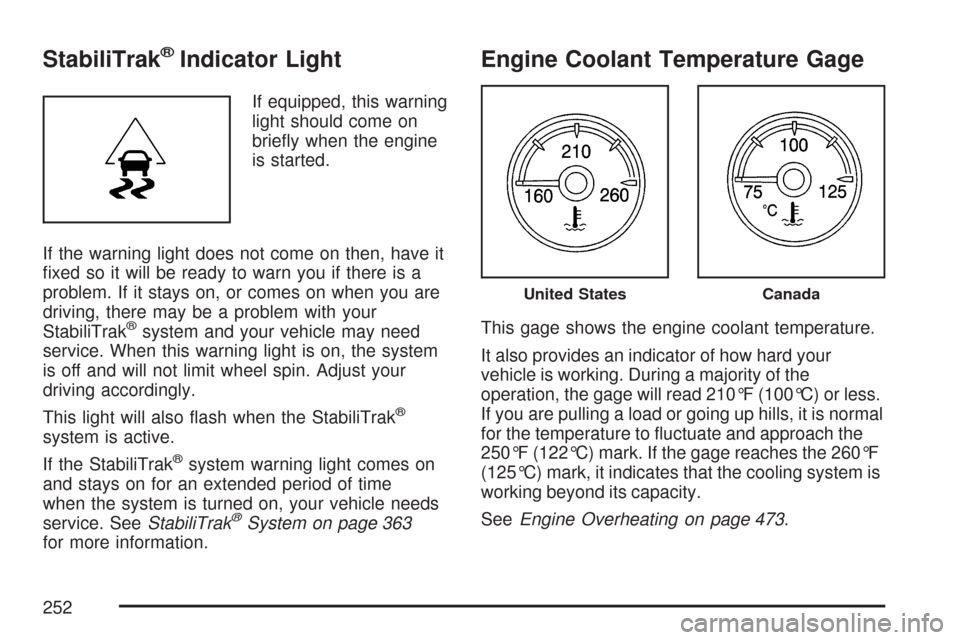
StabiliTrak®Indicator Light
If equipped, this warning
light should come on
brie�y when the engine
is started.
If the warning light does not come on then, have it
�xed so it will be ready to warn you if there is a
problem. If it stays on, or comes on when you are
driving, there may be a problem with your
StabiliTrak
®system and your vehicle may need
service. When this warning light is on, the system
is off and will not limit wheel spin. Adjust your
driving accordingly.
This light will also �ash when the StabiliTrak
®
system is active.
If the StabiliTrak
®system warning light comes on
and stays on for an extended period of time
when the system is turned on, your vehicle needs
service. SeeStabiliTrak
®System on page 363
for more information.
Engine Coolant Temperature Gage
This gage shows the engine coolant temperature.
It also provides an indicator of how hard your
vehicle is working. During a majority of the
operation, the gage will read 210°F (100°C) or less.
If you are pulling a load or going up hills, it is normal
for the temperature to �uctuate and approach the
250°F (122°C) mark. If the gage reaches the 260°F
(125°C) mark, it indicates that the cooling system is
working beyond its capacity.
SeeEngine Overheating on page 473.
United StatesCanada
252